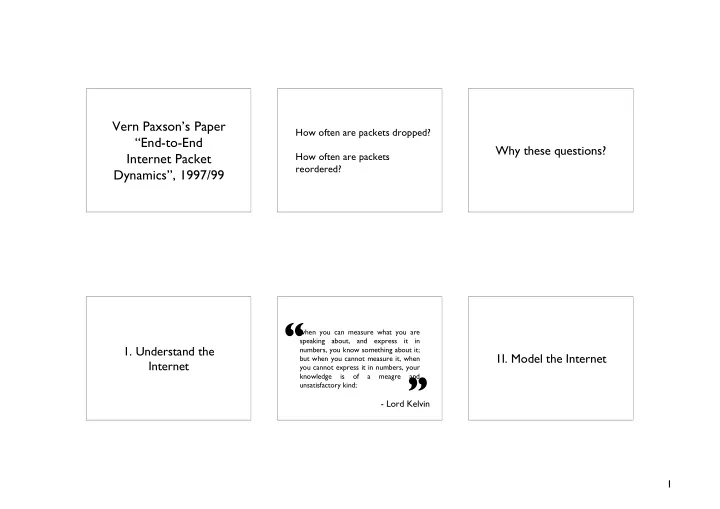

Vern Paxson’s Paper How often are packets dropped? “End-to-End Why these questions? Internet Packet How often are packets reordered? Dynamics”, 1997/99 “ when you can measure what you are speaking about, and express it in 1. Understand the numbers, you know something about it; 1I. Model the Internet but when you cannot measure it, when Internet you cannot express it in numbers, your ” knowledge is of a meagre and unsatisfactory kind; - Lord Kelvin 1
How often are packets dropped? III. Enable more IV. Lead to a better accurate evaluation application/systems How often are packets through simulations design reordered? Trace collection: Collect lots of packet large number of flows How to answer these traces a variety of sites questions? many packets per flow Analyze the traces use TCP 2
Two traces: Time between measurement is 100 kB Poisson distributed N1: Dec94 PASTA Theorem. Intuitively, if we N2: Nov-Dec95 make n observations and k observation is in some state S and n-k in another state, then we can Size of file transfered use tcpdump at sender + receiver assume prob of observing S is approximately k/n. 21 20800 Part 1: The Unexpected Number of sites Number of trace pairs 3
N1 N2 1 36% 12% 2 Packet Reordering 5 2 reorderings 3 Percentage of connections with 4 at least one out-of-order delivery N1 N2 N1 N2 2% .3% .6% .1% Data packets are usually sent closer together. Percentage of data packets out-of-order Percentage of ACK packets out-of-order 4
From To Route fluttering: 15% .2% alternate packets can take different Percentage of packets out-of-order route to dest. to and from U of Colorado in N1. Taken from Paxson’s PhD Thesis: Alternate routes are taken for packets from WUSTL to U Mannheim T1 (new arrival) Ethernet (buffered packets) Impact of Packet Reordering Fig 1 from the paper, showing large gap Fig 1 from the paper, showing large gap and two slopes. and two slopes. 5
N d = 3 is a What if receiver conservative wait longer before choice. sending dup ack? 1 2 5 W Delivery Gap: time between receiving 3 an out-of-order packet and the packet sent before it. 4 6
N1 N2 N2 N1 20 ms 8 ms Is needless retransmission a higher BW problem? Waiting time with which 70% of out of order delivery would be identified. Good Bad N1 N2 22 300 Number of good retransmissions for every bad retransmission. N d = 3, W = 0 7
N1 N2 N1 N2 ~ 7 100 15 300 Packet Corruption Number of good retransmissions Number of good retransmissions for every bad retransmission. for every bad retransmission. N d = 2, W = 0 N d = 2, W = 20ms 1 in 5000 1 in 65536 1 in 300 million corrupted packet goes undetected Internet packet is corrupted packet is corrupted using TCP checksum and is undetected. 8
Part 2: Bottleneck Packet Pair B bps Bandwidth b bytes Q x B = b Q s Q s Q s 9
Q s Problems with 1. Asymmetric Link Packet Pair 2. ACK 3. Out of order 4. Clock resolution Compression delivery 10
5. Changing bottleneck bandwidth Fig 2 from the paper, showing changing bandwidth. Fig 3 from the paper, showing multi-channel links. Measure at receiver: Asymmetric links Asymmetric links ACK compression ACK compression 6. Multi-channel Out-of-order delivery Clock resolution Packet bunch: Links Changes in bottleneck bandwidth Out-of-order delivery Multi-channel links Clock resolution Changes in bottleneck bandwidth Multi-channel links 11
2Q Collect multiple estimates, take the most freq occurrence (modes) as the bottleneck bandwidth. N1 N2 N1 N2 2.7% 5.2% 50% 50% Part 3: Packet Loss Percentage of packets that were lost. Percentage of loss free connections 12
N1 N2 17% 5.7% 9.2% Are packet losses independent? Loss rate on lossy connections Loss rate on connections from EU to US P u P c 2.8% 49% Compute: P u = Pr [ p lost ] P c = Pr [ p lost | prev pkt lost ] Loss rate for “queued data pkt” on N1 Fig 6 from the paper, showing outage duration. 13
Unavoidable Coarse Feedback Are retransmission redundant? Bad RTP N1 N2 26% 28% Percentage of retransmissions that are redundant Type of redundant retransmission in N1. 14
OTT is not well Estimating Part 4: approximated as Available Packet Delay RTT/2 Bandwidth β = 1 means all bandwidth is Q b : time to transit the bottleneck available. ψ i : expected time spend queuing behind predecessor (derived from sending time) β = 0 means none of the γ i : diff between packet OTT and min OTT bandwidth is available. 15
All numbers in the paper Measurement is is not important (the difficult but useful Internet has changed!). Fig 10 from the paper, showing distribution of available bandwidth. We can improve Many new techniques We can identify current design (e.g. needed (e.g to measure problem (e.g. packet TCP if we know more bottleneck bandwidth) corruption) about reordering) 16
We can better model We can infer many info the behavior (e.g. from just a packet trace bursty packet loss) (e.g. available bandwidth) 17
Recommend
More recommend